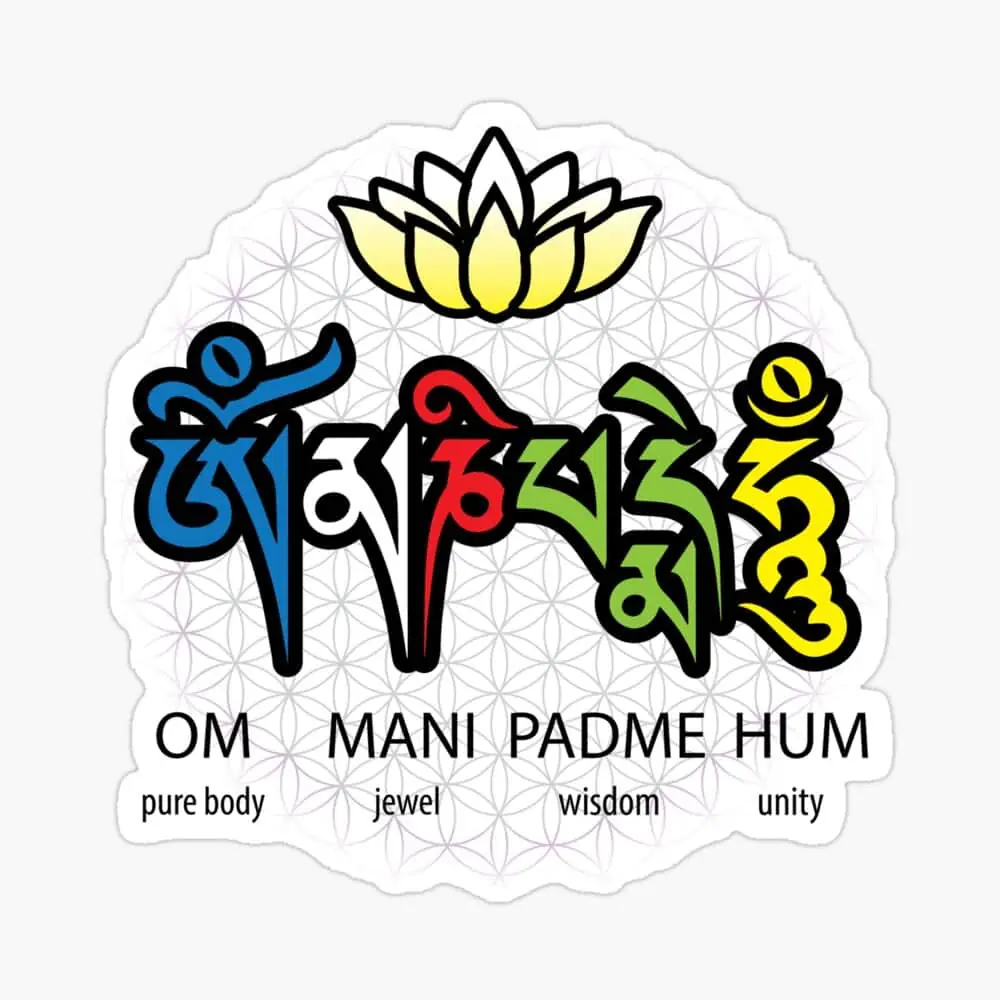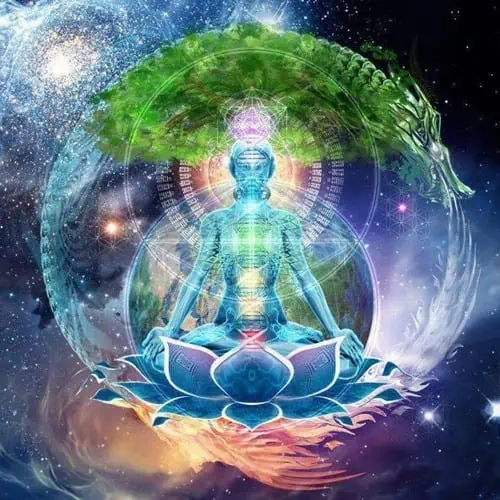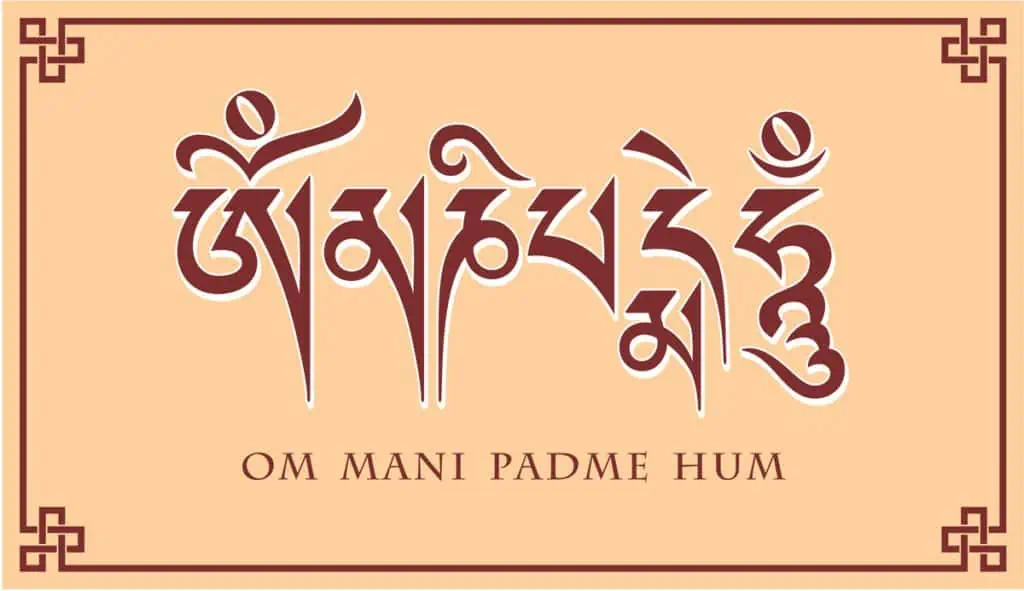The mantra of the Buddha of Compassion first appeared in written form in the Mahayana Karandavyuhasutra at the end of the 4th century. It is thought to be the most condensed form of all of the Buddha’s teachings. The most famous, popular, and beneficial of mantras, it is chanted by hundreds of millions of people every day.
Tibetan Buddhists and lay persons chant om mani padme hum to develop deep compassion, achieve the six perfections, and reach enlightenment.
The general translation goes something like this: “Let the sacred Jewel of my lotus heart shine forth and bring light and joy to the world and to me.” However, the deeper, more precise, and encompassing translation of the mantra is more elusive.
Contents
A Talk On Om Mani Padme Hum By His Holiness the Dalai Lama

It is very good to recite the mantra Om mani padme hum,
but while you are doing it,
you should be thinking on its meaning,
for the meaning of the six syllables is great and vast.
– His Holiness the Fourteenth Dalai Lama
His Holiness the Fourteenth Dalai Lama is a Nobel Peace Laureate, a Congressional Gold Medal recipient, a remarkable spiritual teacher and scholar, an author of over 100 books, and the foremost Buddhist leader of our time.
This section recounts verbatim the words of His Holiness the Dalai Lama regarding the meaning of Om Mani Padme Hum. I offer his exact words first so as not to dilute or misconstrue his teachings. Afterward, I will offer my own summary and interpretation.
Om
The first, Om is composed of three letters. A, U, and M. These symbolize the practitioner’s impure body, speech, and mind; they also symbolize the pure exalted body, speech, and mind of a Buddha.
Can impure body, speech, and mind be transformed into pure body, speech, and mind, or are they entirely separate?
All Buddhas are cases of beings who were like ourselves and then in dependence on the path became enlightened; Buddhism does not assert that there is anyone who from the beginning is free from faults and possesses all good qualities. The development of pure body, speech, and mind comes from gradually leaving the impure states and their being transformed into the pure.
How is this done?
The path is indicated by the next four syllables.
Mani
Mani, meaning jewel, symbolizes the factors of method—the altruistic intention to become enlightened, compassion, and love.
Just as a jewel is capable of removing poverty, so the altruistic mind of enlightenment is capable of removing the poverty, or difficulties, of cyclic existence and of solitary peace.
Similarly, just as a jewel fulfills the wishes of sentient beings, so the altruistic intention to become enlightened fulfills the wishes of sentient beings.
Padme
The two syllables, padme, meaning lotus, symbolize wisdom, just as a lotus grows forth from mud but is not sullied by the faults of mud, so wisdom is capable of putting you in a situation of non-contradiction whereas there would be contradiction if you did not have wisdom.
There is wisdom realizing impermanence, wisdom realizing that persons are empty of being self-sufficient or substantially existent, wisdom that realizes the emptiness of duality—that is to say, of difference of entity between subject and object—and wisdom that realizes the emptiness of inherent existence.
Though there are many different types of wisdom, the main of all these is the wisdom realizing emptiness.
Hum
Purity must be achieved by an indivisible unity of method and wisdom, symbolized by the final syllable hum, which indicates indivisibility. According to the sutra system, this indivisibility of method and wisdom refers to wisdom affected by method and method affected by wisdom.
In the mantra or tantric, vehicle, it refers to one consciousness in which there is the full form of both wisdom and method as one undifferentiable entity.
In terms of the seed syllables of the five Conqueror Buddhas, hum is the seed syllable of Akshobhya—the immovable, the unfluctuating, that which cannot be disturbed by anything.
Thus the six syllables, om mani padme hum, mean that in dependence on the practice of a path which is an indivisible union of method and wisdom, you can transform your impure body, speech, and mind into the pure exalted body, speech, and mind of a Buddha.
It is said that you should not seek for Buddhahood outside of yourself; the substances for the achievement of Buddhahood are within.
As Maitreya says in his Sublime Continuum of the Great Vehicle (Uttaratantra), all beings naturally have the Buddha nature in their own continuum. We have within us the seed of purity, the essence of a One Gone Thus (Tathagatagarbha), that is to be transformed and fully developed into Buddhahood.
“. . . .all beings naturally have the Buddha nature in their own continuum. We have within us the seed of purity…”
Watch this talk by the Dalai Lama on Om Mani Padme Hum below.
Summary and Interpretation of Om Mani Padme Hum

Om
Om is the most recognizable syllable of the mantra, as it is a mantra in itself. It is traditionally chanted to open and close sacred spaces and yoga classes. Om represents the sound of the universe, as well as the creation, manifestation, and destruction of everything.
In order to leave the state of impure body and mind that everyone begins with, you must be open to destruction coming into your life. The impure must be destroyed to make room for the pure. This process is represented in this single syllable, yet manifested throughout the remainder of the mantra: mani padme hum.
Mani
Literally translating to jewel, these two syllables are an important part of the generally translated meaning, “Let the sacred Jewel of my lotus heart shine forth and bring light and joy to the world and to me.”
The jewel represents the altruistic intention of reaching enlightenment in the name of compassion and love. Jewels are often symbols of material wealth. In this instance, though, the jewel fulfills a deeper desire for spiritual and emotional wealth and freedom.
Padme
Padme translates to “lotus,” another central subject of our familiar translation of the mantra. Lotus flowers are significant in Buddhism due to their pure and soft petals that grow out of thick mud. They symbolize wisdom. It is said that because of wisdom, lotus flowers are able to grow and bloom so beautifully without being affected by the dirty and sticky mud surrounding them.
It takes wisdom to trust the life-death-life cycle. It takes wisdom to release old habits, actions, and mindsets in order to make room for new ones. It takes wisdom to be a part of this world yet separate from it, within yet without. Above all, it takes wisdom to realize the value in emptiness.
Hum
The last syllable of the mantra translates to indivisibility. Also present in the mantra, so hum, meaning “I am that.” Hum reminds us that all of consciousness is one and all of nature is one. We are not separate from any other sentient beings. You might also recall that yoga means “union.”
Clearly, unity and indivisibility are integral aspects of achieving purity of mind and body. You must remember that god, the Buddha, the divine mother, everything you seek… is already within you and indivisible from you.
Benefits of Chanting Om Mani Padme Hum Mantra
The Six Perfections
According to many Tibetan Buddhists, the six syllables of the mantra represent the six perfections. Each of these six perfections is a noble quality of an enlightened being. By repeating the mantra, you are inviting each of these qualities into your being.
- Om – generosity
- Ma – ethics
- Ni – patience
- Pad – diligence
- Me – renunciation
- Hum – wisdom
Higher State of Consciousness

In general, mantra chanting is used to reach a deeper state of meditation. The Om mani padme om mantra specifically helps the practitioner reach a state of perfection free of impurities. It is a mantra of love and compassion and healing for all beings.
Improve Cognition

Research has demonstrated that the frequency of each syllable with in om mani padme hum improves cognition by boosting gamma waves. Gamma waves are firing in the brain when focus and concentration are at their peak. They facilitate creative problem solving and information processing.
How to Incorporate the Mantra in Your Daily Practice

There are many ways to use mantras. You may want to chant om mani padme hum before your silent meditation to set a powerful intention and attract positive energy. The repetition of the mantra can bring you into a state of stillness and calmness. It is a beneficial preparation for silent seated meditation. To do this, you have many options.
Ideally, mantras are repeated 108 times with the aid of mala beads. You can repeat om mani padme hum as you move each individual bead through your fingers. The beads will help guide you through the repetitions, and the mantra will charge your mala with positive qualities.
You can recite the mantra:
- Out loud: repeating mantras aloud evokes a response from our surroundings and shifts the vibration of your environment.
- Softly: reciting a mantra softly out loud to yourself invokes a physiological response, such as increased gamma waves.
- Silently: repeating a mantra silently within your consciousness and awareness can lead to a subtle energetic shift within yourself.
- Tuning in: By tuning in to a mantra, you are simply listening to the mantra as it arises in your field of awareness, you are not “doing” the mantra.
- Singing: pairing om mani padme hum with a melody is a beautiful practice. You can sing with a group and instruments with your sangha, spiritual community. Or, you can sing along to a mantra melody by yourself using Spotify or YouTube.
You can chant om mani padme hum any time: while you are in yoga class, doing the dishes, or driving.
As long as you understand the meaning and meditate on it while chanting the mantra, there is no one right way to use mantras.
FAQs
What happens to your body when you chant mantras?
Research shows that chanting mantras helps synchronize the left and right hemispheres of the brain, promotes relaxing brain waves, improves brain functions, and slows cognitive decline.
Why do people chant Om mani padme hum?
It is one way to reach enlightenment and invite love and compassion into your life while also bestowing them out into the universe.
How many times should I chant om mani padme hum?
You should chant the mantra a minimum of 21 times, but ideally 108 times.
What does a lotus flower mean spiritually?
It represents rebirth and resurrection. It is considered a sacred symbol because it depicts the ways of life.



